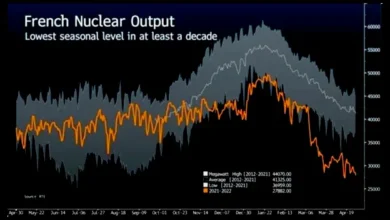Watts Up With That? Solar Set to Be Dominant Power Source by… When? • • Watts Up With That?

Guest “What is never?” by David Middleton
Why does this remind me of the Monty Python Spanish Inquisition skit?
New Research: The World May Have Crossed a Solar “Tipping Point”
By UNIVERSITY OF EXETER OCTOBER 19, 2023
The world may have crossed a “tipping point” that will inevitably make solar power our main source of energy, new research suggests.
The study, based on a data-driven model of technology and economics, finds that solar PV (photovoltaics) is likely to become the dominant power source before 2050 – even without support from more ambitious climate policies.
However, it warns four “barriers” could hamper this…
[…]
“The Momentum of the Solar Energy Transition”
The full text of the paper is available.
Abstract
Decarbonisation plans across the globe require zero-carbon energy sources to be widely deployed by 2050 or 2060. Solar energy is the most widely available energy resource on Earth, and its economic attractiveness is improving fast in a cycle of increasing investments. Here we use data-driven conditional technology and economic forecasting modelling to establish which zero carbon power sources could become dominant worldwide. We find that, due to technological trajectories set in motion by past policy, a global irreversible solar tipping point may have passed where solar energy gradually comes to dominate global electricity markets, without any further climate policies.
[…]
Nobody Expects “the Momentum of the Solar Energy Transition”!
The authors suggest that solar power will become the dominant power source by 2050 without “more ambitious climate policies.” However, four barriers could stand in the way.
Nobody expects “the momentum of the solar energy transition”! Our chief barrier is grid resilience… grid resilience and access to finance… grid resilience and access to finance… Our two barriers are grid resilience and access to finance… and supply chains…. Our three barriers are grid resilience, and access to finance, and supply chains… and an almost fanatical devotion to silencing political opposition… Our four… no… Amongst our barriers… are such elements as grid resilience, access to finance… I’ll come in again.
Overcoming the Solar Barriers
- “Grid Resilience”: Only use electricity only when the sun is shining.
- “Access to finance”: Raise taxes.
- “Supply chains”: Drive up the prices of almost all mineral resources.
- “Political opposition”: Reeducation camps.
Am I Being Flippant?
- Grid resilience: Solar generation is variable (day/night, season, weather) so grids must be designed for this. Dr Nijsse said: “If you don’t put the processes in place to deal with that variability, you could end up having to compensate by burning fossil fuels.” She said methods of building resilience include investing in other renewables such as wind, transmission cables linking different regions, extensive electricity storage, and policy to manage demand (such as incentives to charge electric cars at non-peak times). Government subsidies and funding for R&D are important in the early stages of creating a resilient grid, she added.
- Access to finance: Solar growth will inevitably depend on the availability of finance. At present, low-carbon finance is highly concentrated in high-income countries. Even international funding largely favors middle-income countries, leaving lower-income countries – particularly those in Africa – deficient in solar finance despite the enormous investment potential.
- Supply chains: A solar-dominated future is likely to be metal- and mineral-intensive. Future demand for “critical minerals” will increase. Electrification and batteries require large-scale raw materials such as lithium and copper. As countries accelerate their decarbonization efforts, renewable technologies are projected to make up 40% of the total mineral demand for copper and rare earth elements, between 60 and 70% for nickel and cobalt, and almost 90% for lithium by 2040.
- Political opposition: Resistance from declining industries may impact the transition. The pace of the transition depends not only on economic decisions by entrepreneurs but also on how desirable policymakers consider it. A rapid solar transition may put at risk the livelihood of up to 13 million people worldwide working in fossil fuel industries and dependent industries. Regional economic and industrial development policies can resolve inequity and can mitigate risks posed by resistance from declining industries
“Even without support from more ambitious climate policies”
Can someone please explain to me how they plan to overcome these barriers “without support from more ambitious climate policies” (AKA massive government intervention)?
Nijsse et al., 2023 envisions the following energy transition:
Bear in mind, this is where we are now in the USA:
Solar power is very dependent on… the Sun. The annular eclipse on October 14, 2023, did this to ERCOT’s solar power at high noon on a sunny day:
The loss of solar generation was accompanied by the usual midday doldrum. 4,904 MW of solar and wind generation tool a lunch break that day. Fortunately, it occurred on a Saturday, the high temperature was only 63 °F and natural gas-fired generation quickly ramped up to fill the gap.
| Timestamp (Hour Ending) | Wind (MWh) | Wind (ΔMWh) | Solar (MWh) | Solar (ΔMWh) | Natural gas (MWh) | Natural gas (ΔMWh) | Coal (MWh) | Coal (ΔMWh) | Nuclear (MWh) | Nuclear (ΔMWh) |
| 10/14/2023 11 a.m. CDT | 12,665 | 6,100 | 13,271 | 5,045 | 5,045 | |||||
| 10/14/2023 12 p.m. CDT | 9,709 | (2,956) | 4,152 | (1,948) | 17,889 | 4,618 | 5,763 | 718 | 5,046 | 1 |
| 10/14/2023 1 p.m. CDT | 7,120 | (2,589) | 5,981 | 1,829 | 18,023 | 134 | 6,164 | 401 | 5,048 | 2 |
There Has Never Been an Energy Transition
All of the blather about the “energy transition” omits a very pertinent fact: There has never been an energy transition. Nor will there ever be an actual energy transition unless we manage to harness nuclear fusion.
We never transitioned from traditional biomass to fossil fuels. On a per capita basis, we consume as much “traditional biomass” for energy as we did when we started burning coal. We have just piled new forms of energy on top of older ones. Now, we have changed the way we consume energy sources. In the 1800’s the biomass came from whale oil and clear-cutting forests. Whereas, today’s biomass is less harmful to whales and forests.
From 1800 to 1900, per capita energy consumption, primarily from biomass, remained relatively flat; as did the average life expectancy. From 1900 to 1978, per capita energy consumption roughly tripled with the rapid growth in fossil fuel (coal, oil & natural gas) consumption. This was accompanied by a doubling of average life expectancy. While I can’t say that fossil fuels caused the increase in life expectancy, I can unequivocally state that everything that enabled the increase in life expectancy wouldn’t have existed or happened without fossil fuels, particularly petroleum.
It’s simply absurd to claim that solar power will ever become the dominant power source, with or “without any further climate policies.” Nobody should expect an energy transition. Wishful thinking dressed up as scientific research just encourages politicians to make bad policy decisions.
“Nobody Expects the Spanish Inquisition!”
I just had to include this:
Reference
Nijsse, F.J.M.M., Mercure, JF., Ameli, N. et al. The momentum of the solar energy transition. Nat Commun 14, 6542 (2023). https://doi.org/10.1038/s41467-023-41971-7



